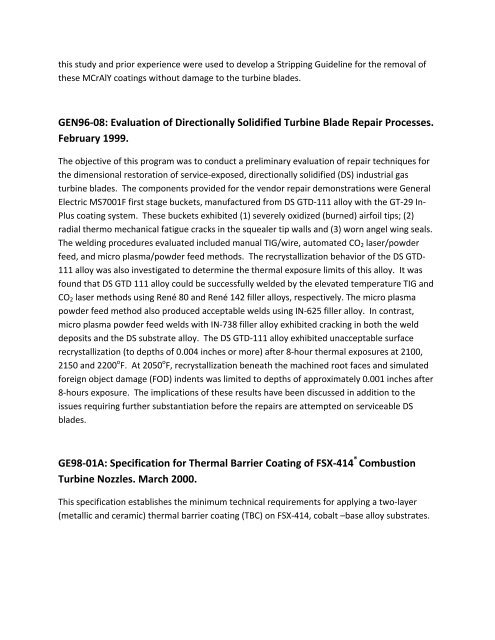GE94-02: Repair Flow Testing and Calibration Procedures for ...
GE94-02: Repair Flow Testing and Calibration Procedures for ...
GE94-02: Repair Flow Testing and Calibration Procedures for ...
You also want an ePaper? Increase the reach of your titles
YUMPU automatically turns print PDFs into web optimized ePapers that Google loves.
this study <strong>and</strong> prior experience were used to develop a Stripping Guideline <strong>for</strong> the removal of<br />
these MCrAlY coatings without damage to the turbine blades.<br />
GEN96‐08: Evaluation of Directionally Solidified Turbine Blade <strong>Repair</strong> Processes.<br />
February 1999.<br />
The objective of this program was to conduct a preliminary evaluation of repair techniques <strong>for</strong><br />
the dimensional restoration of service‐exposed, directionally solidified (DS) industrial gas<br />
turbine blades. The components provided <strong>for</strong> the vendor repair demonstrations were General<br />
Electric MS7001F first stage buckets, manufactured from DS GTD‐111 alloy with the GT‐29 In‐<br />
Plus coating system. These buckets exhibited (1) severely oxidized (burned) airfoil tips; (2)<br />
radial thermo mechanical fatigue cracks in the squealer tip walls <strong>and</strong> (3) worn angel wing seals.<br />
The welding procedures evaluated included manual TIG/wire, automated CO2 laser/powder<br />
feed, <strong>and</strong> micro plasma/powder feed methods. The recrystallization behavior of the DS GTD‐<br />
111 alloy was also investigated to determine the thermal exposure limits of this alloy. It was<br />
found that DS GTD 111 alloy could be successfully welded by the elevated temperature TIG <strong>and</strong><br />
CO2 laser methods using René 80 <strong>and</strong> René 142 filler alloys, respectively. The micro plasma<br />
powder feed method also produced acceptable welds using IN‐625 filler alloy. In contrast,<br />
micro plasma powder feed welds with IN‐738 filler alloy exhibited cracking in both the weld<br />
deposits <strong>and</strong> the DS substrate alloy. The DS GTD‐111 alloy exhibited unacceptable surface<br />
recrystallization (to depths of 0.004 inches or more) after 8‐hour thermal exposures at 2100,<br />
2150 <strong>and</strong> 2200 o F. At 2050 o F, recrystallization beneath the machined root faces <strong>and</strong> simulated<br />
<strong>for</strong>eign object damage (FOD) indents was limited to depths of approximately 0.001 inches after<br />
8‐hours exposure. The implications of these results have been discussed in addition to the<br />
issues requiring further substantiation be<strong>for</strong>e the repairs are attempted on serviceable DS<br />
blades.<br />
GE98‐01A: Specification <strong>for</strong> Thermal Barrier Coating of FSX‐414 ® Combustion<br />
Turbine Nozzles. March 2000.<br />
This specification establishes the minimum technical requirements <strong>for</strong> applying a two‐layer<br />
(metallic <strong>and</strong> ceramic) thermal barrier coating (TBC) on FSX‐414, cobalt –base alloy substrates.


